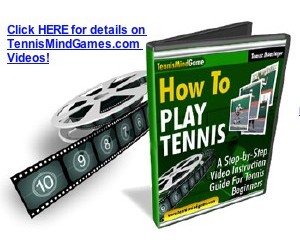September 2007 Article Turbo Tennis Archives:
Tennis Server
|

 |
When tennis is played at its best, there is an effortless coordination between the conscious mind and what many refer to as muscle memory. Watching players like Justin Henin and Roger Federer blend these together in matches beautiful to say the least. Bringing these two elements together in harmony in our own games is ecstasy! Those of you who read my column on a regular basis know that I have a firm belief that the conscious mind should be alert but not thinking per se during match play. The analytical nature of the conscious mind can really mess up a person’s game. To prove my point, consider the following. You are playing a point. You have finally been given a short ball by your opponent. You are moving in for the kill. You have practiced the crosscourt put away shot over and over. It is where you "naturally" want to place this winning shot. As you setup, you change your mind and decide to go down the line instead. Result? You miss the shot and the opponent wins the point. The conscious mind got in your way. Another example? You are at the baseline ready to serve your second serve. A thought for unknown reasons pops into your conscious mind, "I am going to double fault." Sure enough, you do indeed miss your second point. Here again, the conscious mind got in your way.
Being consciously mindless on the court is not all that desirable either. For example, not realizing that you are playing a lefty (assuming this is a new, unknown opponent) happens more frequently than you imagine. Not knowing which is your opponent’s better wing (forehand or backhand), is a cardinal mistake in competition. Only the conscious mind can arrive at these insights. So, truly "perfect" tennis requires both conscious thought and "autopilot" muscle memory. When you have both going at the right times, your game can literally soar to new heights. When playing a point, it is of key importance to put the conscious mind on "awareness only" mode. Don’t evaluate what is going on during the point. Simply, try to observe what is going on, and be alert with respect to the ball. If you are focused on the ball with a relaxed body and quiet mind, you will probably find that your muscle memory kicks in quite nicely. The time to let the conscious mind be analytical (and it is always striving to be analytical) is in between points, or better yet, during game changeovers. There are lots of ways to quiet the conscious mind, and if you are like most tennis players, you will need to use all of them. To have muscle memory you need to practice. Drills, practice matches, backboard work, etc. need to be done regularly to allow the other-than-conscious-mind the opportunity to learn what it needs to learn. Having said all of this, my column this month is going to focus upon mindless movement on the court. We spend lots of time practicing our strokes, but very little time working on how we move to the ball. If we move to every ball in an appropriate manner, our chances of hitting well go up precipitously! First, there is the need to do foot drills to help our muscle memory mind learn how to move appropriately. Here are two drills that I believe are the most beneficial to helping this learning occur in a rapid manner.
So with these two foot drills, you are beginning to drill into your muscle memory the basics of proper court movement. However, applying them in a match requires some different practice. When you are practicing with your hitting partner, dedicate a little focus to how you approach a ball to hit it. I believe that the mind should have easy to remember methods of moving to balls and following shots/serves. If you spend some time working on the following in your practice sessions, you will find that your conscious mind will not need to remind you how to move in a match. Your muscle memory mind will have been trained to incorporate these into your "autopilot." When moving to hit a ground stroke, always move as if you want the ball to hit the center of your chest. This technique will automatically force you to be at the right height to hit the ball properly. If the ball is bouncing low, your chest goes down, and you are forced to bend at the knees, not the waist. If the ball is bouncing high, you will find yourself going up on your toes, as you should to make proper contact with the ball. In my "off season" I will even practice this movement using a wall or backboard to refresh my muscle memory’s hard drive. I promise you that if you move to each ground stroke in this manner, your footwork will improve automatically without any analytical process needed. You will find your timing to the ball automatically improves because this technique will force you to make little mini-step adjustments as you approach the ball. If you need to run to get to a wide ball, this technique automatically will help you make a great first step, which needs to be a powerful stride. When volleying, the secret to proper movement is to pretend that you want the tennis ball to hit your head. (Not to worry. This won’t happen.) I learned this technique from Oscar Wegner some years back. It is simply the best way to teach proper movement at the net. You will bend your knees when you should and you will find yourself moving forward after each volley. After you have hit your shots, proper movement is still needed! Again, I have some guidelines to help you deliberately work on this during your practice sessions. After hitting a ground stroke, the rule has always been to get back to the center of the court. This is well founded, but I would modify the adage a bit. After hitting a ground stroke, drift back toward the center of the court. This drifting will necessitate the use of side steps which we practiced in the two drills described earlier. By drifting, you have time to really see the ball come off your opponent’s strings. If you are focusing your conscious mind on just seeing this, you will automatically know what direction in which you need to move. By drifting, you will have enough time to run to a ball that is going to force you wide, and you will probably find that you are rarely, if ever, having a ball hit behind you. With serve/volley, chip/charge, approach shots and volleys…always follow the path of the ball. (If you are not planning on following your serve in, you will, of course, not be following your ball.) With all of the shots mentioned above, I have observed coaches and tennis teaching pros make what is very simple become very complicated. By following the ball, I mean this. Let’s say that I am serve and volleying. I hit my serve wide to the deuce court to my opponent’s forehand (assume he or she is right handed). Well, the path of my service was a line that moves to my left. If in my imagination, I follow the path that the ball actually traveled, I will automatically be in the ideal position for my volley. I may get passed, or I may miss the volley… but my court position will be ideal, given my opponent’s possible replies. Let’s say that I am hitting a backhand slice approach shot down the line. I, again, should follow the path of the ball which would have me move straight ahead. Now, I am probably somewhere between the center strap and the left hand post (I am right handed). I am automatically in the ideal place to cover both of the possible replies (down the line or crosscourt). Statistically, the down the line response is more common. By following the path of my approach shot, I am shading a little bit in favor of this reply. In the volley game, it is imperative that the net person be prepared to hit another volley. This is definitely the case in doubles. By moving in the direction of my volley, I am automatically positioning myself in the most ideal location for a second volley if needed. Finally, we have the movement associated with moving back to hit an overhead smash. Again, there is a simple way to practice these where you muscle memory will take over and your conscious mind needs only to see the ball. Pretend that you want to catch the lobbed ball with your non-racquet hand. In doing this, you body will automatically move as it should to put you in a position to hit the best possible overhead. You will find that if you have practiced the aforementioned drills that your feet will either move in crossover steps or rapid back pedal steps as needed. You won’t have to think about it, it will just happen. Hopefully where you live, you will have a few more months of great tennis weather. This game is, in my mind, best played outside in the elements. However, many of us north of the equator are going to find ourselves playing less tennis during the winter months. This is not a bad thing. We all need give our minds and bodies some rest from competition. But, I promise you… If you spend the remaining time till the spring rolls around again practicing these two foot drills, and consciously training your muscle memory to learn "mindless movement" on the court, you will be a definite, tennis overdog!!!
1996 - 2002 | 2003 - Present
This column
is copyrighted by Ron Waite, all rights reserved. Questions and comments
about these columns can be directed to Ron by using this form.
Ron Waite is a certified USPTR tennis instructor who took up the game
of tennis at the age of 39. Frustrated with conventional tennis methods
of instruction and the confusing data available on how to learn the
game, Ron has sought to sift fact from fiction. In his seven years of
tennis, Ron has received USTA sectional ranking four years, has successfully
coached several NCAA Division III men's and women's tennis teams to
post season competition, and has competed in USTA National singles tournaments.
Ron has trained at a number of tennis academies and with many of the
game's leading instructors.
In addition to his full-time work as a professor at Albertus Magnus
College, Ron photographs ATP tour events for a variety of organizations
and publications. The name of his column, TurboTennis, stems from his
methods to decrease the amount of time it takes to learn and master
the game of tennis.
|



October 2022 Tennis Anyone: Patterns in Doubles by John Mills. September 2022 Tennis Anyone: Short Court by John Mills. |
 You will join 13,000 other subscribers in receiving news of updates to the Tennis Server along with monthly tennis tips from tennis pro Tom Veneziano.
You will join 13,000 other subscribers in receiving news of updates to the Tennis Server along with monthly tennis tips from tennis pro Tom Veneziano. 

